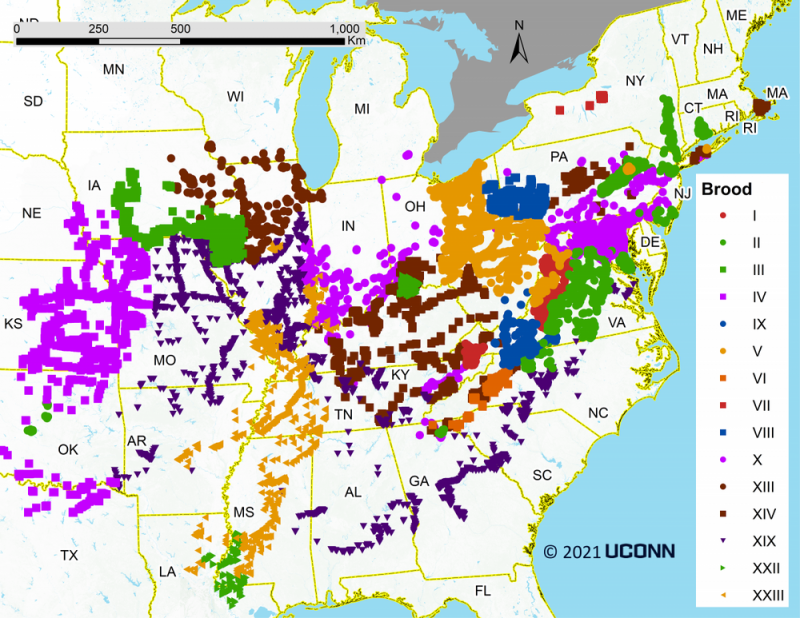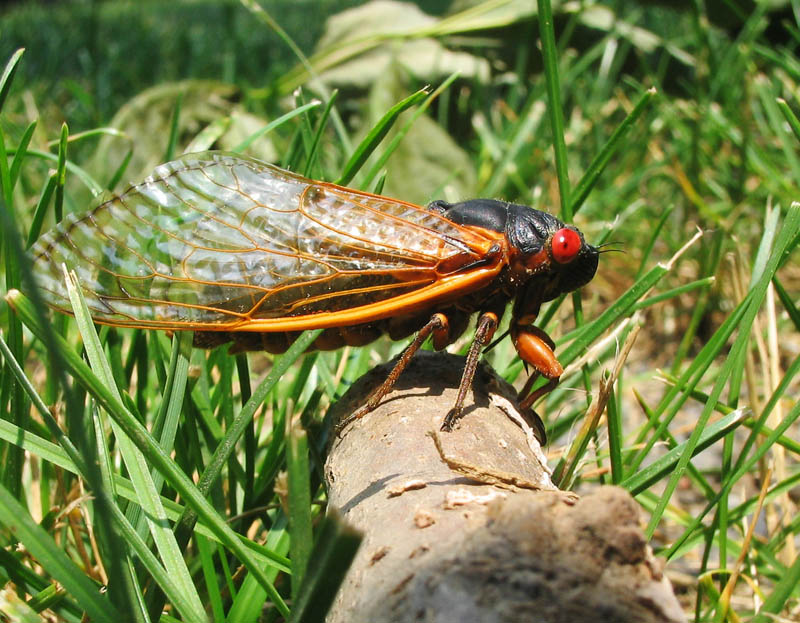
Starting sometime this month or next (April-May 2021), billions of cicadas will emerge, after 17 years underground, in a dozen U.S. states, from New York west to Illinois and south into northern Georgia, including hot spots in Indiana, Ohio, Tennessee, Maryland, Pennsylvania and New Jersey. This group of cicadas, known as Brood X (as in the Roman numeral 10) is among the geographically largest of all 17-year periodical cicadas.
When exactly will the Brood X cicadas emerge? The timing of their appearance varies by location, said West Virginia University biologist Matt Kasson. He told the New York Times:
They are ready but waiting for the soil to be warm enough. The ideal soil temperature for cicadas is about 64 degrees. For the Mid-Atlantic region, that usually comes by about the third week of May, but it could be sooner. Usually, you have stragglers on either side.
For about four to six weeks after the cicadas emerge, woods and neighborhoods will ring with their buzzing mating calls. After the cicadas mate, each female will lay hundreds of eggs in thin tree branches. Then the adult cicadas will die. When the eggs hatch, new cicada nymphs (cicadas before they’re fully grown) will fall from the trees and burrow back underground, starting the 17-year cycle again.
The cicadas won’t hurt you. They don’t sting and they’re not venomous. Cicadas get a bad rap because they remind people of the biblical plagues of locusts (a different insect) that would eat entire crop fields. But the cicadas set to emerge this spring in the United States are harmless to humans and won’t wipe out fields or gardens.

Broods of periodical cicadas, identified by Roman numerals, emerge on 13- or 17-year cycles across the eastern and midwestern U.S. Image via University of Connecticut.
There are perhaps 3,000 to 4,000 species of cicadas around the world, but the 13- and 17-year periodical cicadas are unique to eastern North America.
After 17 years underground, sucking sap from tree roots, the cicadas will surface en masse. Dime-sized holes (about 2 cm) will litter the ground where the emerging nymphs crawl up toward daylight. The cicadas’ only defense against predators is to arise together in an enormous swarm, overwhelming the predators’ ability to eat them all. This technique is called predator satiation. As many as 1.5 million cicadas per acre can cover some areas of the eastern United States.
Once above ground, the cicadas announce their arrival. The main aggravation cicadas inflict on the rest of us is their loud, buzzing mating call. The males head toward the tops of trees and let out a loud whirring noise that can fill the air at up to 80 to 100 decibels, equal to the intensity of a lawn mower or motorcycle. During the last emergence of the Brood X cicadas in 2004, the PGA’s Memorial Tournament in Dublin, Ohio, was awash in the nonstop buzz of cicadas, providing a noisy backdrop to television coverage as the golfers played 72 holes over the course of 4 days.

The Brood X cicadas return in spring 2021 after a 17-year absence. Image via Wikipedia.
The main damage that cicadas inflict on the landscape comes when female cicadas drill holes into slender tree branches, where they then lay their eggs. To protect younger or vulnerable trees, cover them with netting to keep the cicadas away.
The eggs deposited by the females will eventually hatch, producing nymphs the size of a grain of rice. Those nymphs fall off the trees and burrow underground, beginning their 17 years of subterranean life, while above ground, their parents end their life stage, the carcasses piling up under trees and on the grass, returning nutrients to the soil that will feed the trees and eventually their children, who dine off the sap of the tree roots.
The whole cycle of emergence, predation, mating, birth and death will take place over the course of about six weeks before the landscape again returns to its former state to await the next emergence in 2038.
Bottom line: After 17 years underground, more than a billion Brood X cicadas will emerge in spring 2021 across parts of the United States.
from EarthSky https://ift.tt/3tuot2J

Starting sometime this month or next (April-May 2021), billions of cicadas will emerge, after 17 years underground, in a dozen U.S. states, from New York west to Illinois and south into northern Georgia, including hot spots in Indiana, Ohio, Tennessee, Maryland, Pennsylvania and New Jersey. This group of cicadas, known as Brood X (as in the Roman numeral 10) is among the geographically largest of all 17-year periodical cicadas.
When exactly will the Brood X cicadas emerge? The timing of their appearance varies by location, said West Virginia University biologist Matt Kasson. He told the New York Times:
They are ready but waiting for the soil to be warm enough. The ideal soil temperature for cicadas is about 64 degrees. For the Mid-Atlantic region, that usually comes by about the third week of May, but it could be sooner. Usually, you have stragglers on either side.
For about four to six weeks after the cicadas emerge, woods and neighborhoods will ring with their buzzing mating calls. After the cicadas mate, each female will lay hundreds of eggs in thin tree branches. Then the adult cicadas will die. When the eggs hatch, new cicada nymphs (cicadas before they’re fully grown) will fall from the trees and burrow back underground, starting the 17-year cycle again.
The cicadas won’t hurt you. They don’t sting and they’re not venomous. Cicadas get a bad rap because they remind people of the biblical plagues of locusts (a different insect) that would eat entire crop fields. But the cicadas set to emerge this spring in the United States are harmless to humans and won’t wipe out fields or gardens.

Broods of periodical cicadas, identified by Roman numerals, emerge on 13- or 17-year cycles across the eastern and midwestern U.S. Image via University of Connecticut.
There are perhaps 3,000 to 4,000 species of cicadas around the world, but the 13- and 17-year periodical cicadas are unique to eastern North America.
After 17 years underground, sucking sap from tree roots, the cicadas will surface en masse. Dime-sized holes (about 2 cm) will litter the ground where the emerging nymphs crawl up toward daylight. The cicadas’ only defense against predators is to arise together in an enormous swarm, overwhelming the predators’ ability to eat them all. This technique is called predator satiation. As many as 1.5 million cicadas per acre can cover some areas of the eastern United States.
Once above ground, the cicadas announce their arrival. The main aggravation cicadas inflict on the rest of us is their loud, buzzing mating call. The males head toward the tops of trees and let out a loud whirring noise that can fill the air at up to 80 to 100 decibels, equal to the intensity of a lawn mower or motorcycle. During the last emergence of the Brood X cicadas in 2004, the PGA’s Memorial Tournament in Dublin, Ohio, was awash in the nonstop buzz of cicadas, providing a noisy backdrop to television coverage as the golfers played 72 holes over the course of 4 days.

The Brood X cicadas return in spring 2021 after a 17-year absence. Image via Wikipedia.
The main damage that cicadas inflict on the landscape comes when female cicadas drill holes into slender tree branches, where they then lay their eggs. To protect younger or vulnerable trees, cover them with netting to keep the cicadas away.
The eggs deposited by the females will eventually hatch, producing nymphs the size of a grain of rice. Those nymphs fall off the trees and burrow underground, beginning their 17 years of subterranean life, while above ground, their parents end their life stage, the carcasses piling up under trees and on the grass, returning nutrients to the soil that will feed the trees and eventually their children, who dine off the sap of the tree roots.
The whole cycle of emergence, predation, mating, birth and death will take place over the course of about six weeks before the landscape again returns to its former state to await the next emergence in 2038.
Bottom line: After 17 years underground, more than a billion Brood X cicadas will emerge in spring 2021 across parts of the United States.
from EarthSky https://ift.tt/3tuot2J

Aucun commentaire:
Enregistrer un commentaire